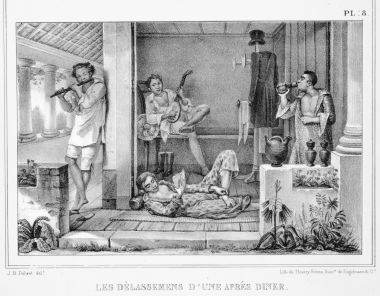
Jean-Baptiste Debret, “Les dèlassemens d’une aprés diner,” from Voyage Pittoresque et Historique au Brésil, vol. 2 (Paris: Firmin Didot Frerès, 1835)
Today’s guest post comes from Rachel Zimmerman (Ph.D., University of Delaware), Assistant Professor of Art History at Colorado State University-Pueblo. She has been studying the art and architecture of the Brazilian town of Minas Gerais since her first trip to the region in 2006. She began examining consumption in colonial Brazil for her dissertation, “Global Luxuries at Home: The Material Possessions of an Elite Family in Eighteenth-Century Minas Gerais, Brazil,” and is continuing research for a book project on elite material culture in the city of Mariana. Follow her work here.
According to the early nineteenth-century English merchant John Luccock, it was customary for Brazilian men to discard stiff outer layers when at home and wear only a cotton shirt, often unbuttoned, knee-length breeches, and clogs.[1] Brazilian standards of decorum permitted informal dress in domestic settings, even when receiving guests. Examination of colonial-era probate inventories from Minas Gerais, the gold mining district, reveals that a small number of educated elite men transformed their state of undress from ordinary to stylish with the addition of a nightgown. Continue reading
 Dear Junto readers, Thank you for joining us for two weeks of all-new scholarship tracing the historical patterns of #ColonialCouture! Read the whole roundtable
Dear Junto readers, Thank you for joining us for two weeks of all-new scholarship tracing the historical patterns of #ColonialCouture! Read the whole roundtable 



 Today’s #ColonialCouture post is by Amy Sopcak-Joseph, a doctoral candidate in American history at the University of Connecticut. She is working on her dissertation, “Fashioning American Women: Godey’s Lady’s Book, Female Consumers, and Periodical Publishing in the Nineteenth Century.” Follow her @AmySopcakJoseph.
Today’s #ColonialCouture post is by Amy Sopcak-Joseph, a doctoral candidate in American history at the University of Connecticut. She is working on her dissertation, “Fashioning American Women: Godey’s Lady’s Book, Female Consumers, and Periodical Publishing in the Nineteenth Century.” Follow her @AmySopcakJoseph.

